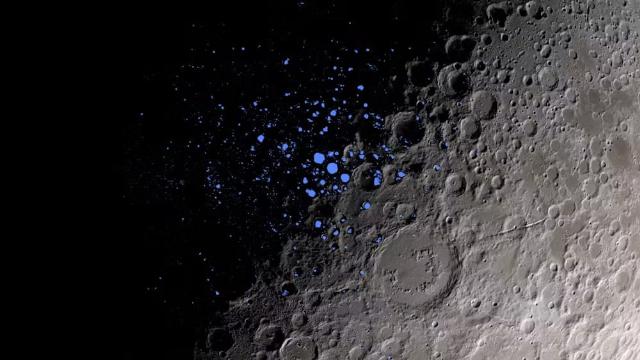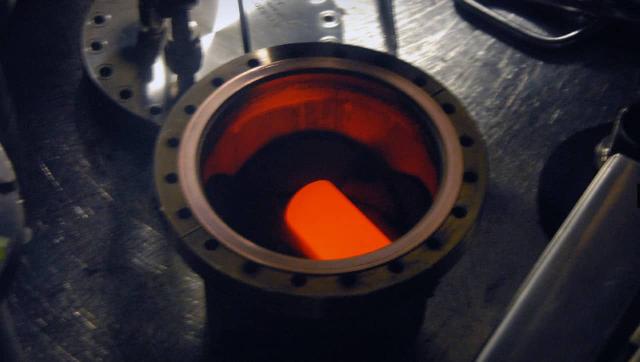According to current space agreements, a nuclear reactor located on another celestial body will force other countries to "bypass it," effectively making the corresponding piece of territory controlled by the country that manages this reactor. Although these are not terrestrial territorial claims, we are talking about a fairly effective control mechanism, a kind of "sphere of influence" outside the Earth. This will be especially in demand in the area where important resources are located.
Energy production on the Moon and Mars is one of the most difficult tasks in the exploration of these celestial bodies. Solar panels there provide a lot of energy, but they do it intermittently. For example, on the Moon, with its night of 14 Earth days, it is necessary to accumulate energy from solar cells in very bulky and heavy batteries. Moreover, the richest water ice and therefore the most interesting zones on the satellite are located in the craters of the eternal shadow at the poles. But the closer to the pole, the more difficult it can be to use sunlight, because there it falls at a small angle.
The slopes of some lunar "peaks of eternal light" are illuminated 90 percent of the time a year. But there is another major problem: these slopes are steep enough to become a problem even for a climber on Earth. All spacesuits ever created reduce human mobility so much that installing solar panels there will be on the verge of being possible, if not beyond it.
Because of all this, nuclear reactors have long been considered as the most sensible option for energy supply to lunar and then Martian bases. The reactor does not need batteries, it can be placed anywhere, and very compactly, and not on thousands of square meters, like solar panels. It works most effectively in areas with the lowest temperatures and the least illumination: it is easier for metal radiators to give off heat there. This means that it will work best where and when its energy is needed most — in the craters of the eternal shadow, where minus 190 degrees Celsius and below are stable, in deep valleys on Mars, and so on.
Now, in an article for The Conversation, lawyer Michelle Hanlon from the University of Missouri, specializing in space law, highlighted another advantage that a nuclear reactor on another celestial body provides.
"If any State party to the treaty has reason to believe that an activity or experiment planned by that State party to the treaty or by nationals of that State <...> will create potentially harmful interference with the activities of other States parties to the treaty, <...> it should conduct appropriate international consultations before embarking on such activities or experiment," says article IX of the Outer Space Treaty of 1967.
Hanlon translates this piece from legal to universal as follows: if a country places a reactor on the moon, others will have to bypass it, both legally and physically. This is extremely important, since existing treaties prohibit territorial claims in outer space — but a zone that cannot be entered without consulting another state will, in fact, have a lot in common with the territory of a state in the sense in which it is understood on Earth.

The eternal shadow craters in the image are shown in blue
Image source: NASA's Goddard Space Flight Center
The specifics of the operation of a nuclear reactor in space are such that it will inevitably require cooling systems, if damaged, the reactor core may overheat and it will self-shut down. Moreover, the possibility of restarting it in space conditions is not yet clear, since so far there have been no such precedents. Many of the reactors that the USSR launched into space were always in orbit and never on another celestial body.
All this leaves great opportunities for setting restrictions on approaching someone else's nuclear reactor. Moreover, on the Moon, dust even from an ordinary lunar vehicle, such as those that American astronauts used half a century ago, can spread dozens or even hundreds of meters from the vehicle itself, and it will be very difficult to remove it from the cooling radiators.
The lawyer stopped at one more point. Article IX does not describe restrictions on nuclear reactors in detail. Thus, whoever first delivers and activates the Selenium reactor will set a legal precedent and establish such rules and regulations.
This gives a new twist to the plans of the United States and China to install a nuclear reactor on the Moon by the early 2030s. This year, NASA (" by 2030 ") and China ( probably by 2035 ) announced such plans. The Russian side also intends to participate by delivering its own reactor there on Chinese ships, since it will not have its own with the necessary capabilities for the Moon in the foreseeable future (at least until the mid-2030s).
From a technical point of view, the United States should be the first to land people on the Moon in the 21st century, since their ship for these purposes (Starship) has already passed a significant part of the development cycle. China has not yet raised its "hardware" of this kind above the Pocket line (the boundaries of space), plus what it is currently developing in terms of ships is quite small in size, and it is not obvious that it can be used to deliver a reactor to another planet.
Interestingly, Hanlon's theses apply equally well to Mars. There is also a valuable resource there (water ice under the surface), which is even more valuable locally than lunar ice. The fact is that Tsiolkovsky's formula practically excludes any options for the regular return of people from the fourth planet without extracting fuel from local resources.
Liquid methane and oxygen can be produced from carbon dioxide from the Martian atmosphere and oxygen + hydrogen from local water ice, fueled by Starship and its future Chinese clones. However, there are not many places where water ice is close to the surface. By installing a reactor near such a point, it is possible to obtain a legal lever that prevents other states and their companies from using such "outlets" of water ice to the surface.

